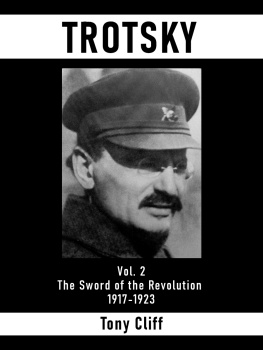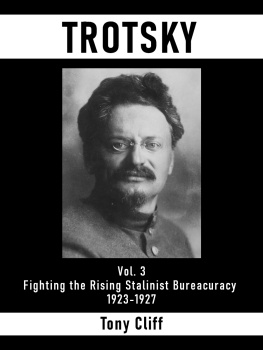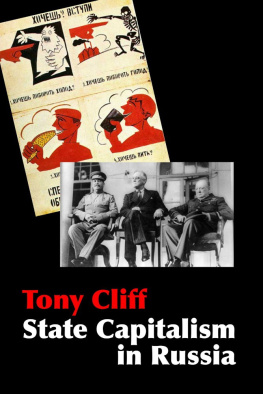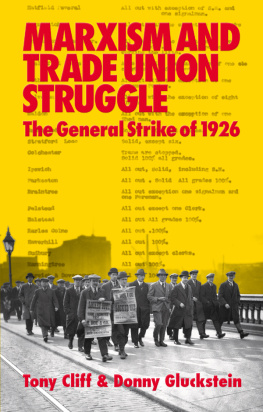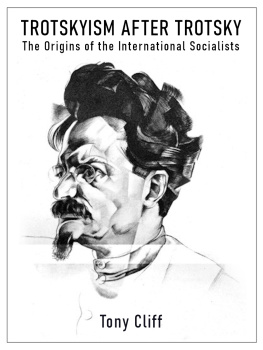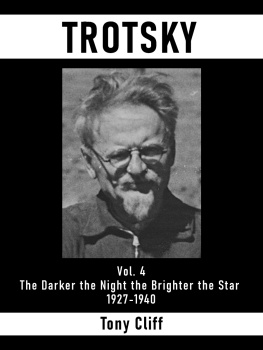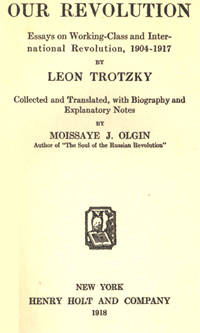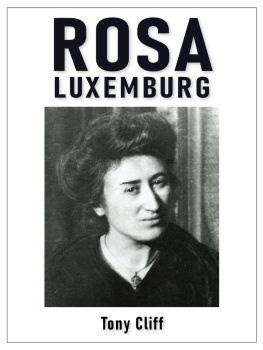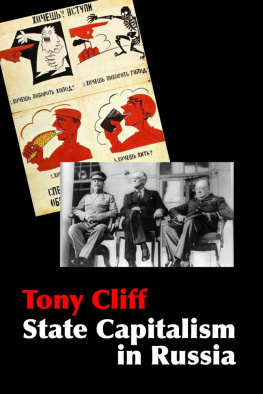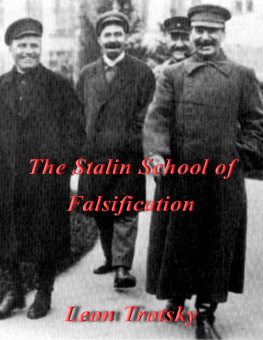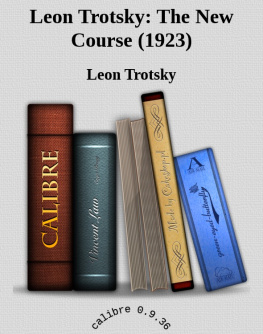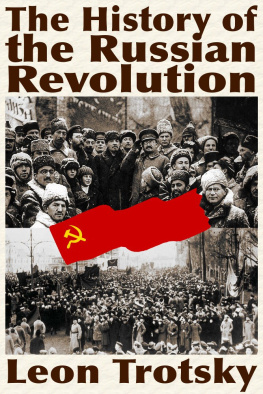Tony Cliff - Trotsky: Vol. 2. The Sword of the Revolution 1917-1923
Here you can read online Tony Cliff - Trotsky: Vol. 2. The Sword of the Revolution 1917-1923 full text of the book (entire story) in english for free. Download pdf and epub, get meaning, cover and reviews about this ebook. year: 2020, publisher: Marxists Internet Archive, genre: Politics. Description of the work, (preface) as well as reviews are available. Best literature library LitArk.com created for fans of good reading and offers a wide selection of genres:
Romance novel
Science fiction
Adventure
Detective
Science
History
Home and family
Prose
Art
Politics
Computer
Non-fiction
Religion
Business
Children
Humor
Choose a favorite category and find really read worthwhile books. Enjoy immersion in the world of imagination, feel the emotions of the characters or learn something new for yourself, make an fascinating discovery.
- Book:Trotsky: Vol. 2. The Sword of the Revolution 1917-1923
- Author:
- Publisher:Marxists Internet Archive
- Genre:
- Year:2020
- Rating:4 / 5
- Favourites:Add to favourites
- Your mark:
- 80
- 1
- 2
- 3
- 4
- 5
Trotsky: Vol. 2. The Sword of the Revolution 1917-1923: summary, description and annotation
We offer to read an annotation, description, summary or preface (depends on what the author of the book "Trotsky: Vol. 2. The Sword of the Revolution 1917-1923" wrote himself). If you haven't found the necessary information about the book — write in the comments, we will try to find it.
Trotsky: Vol. 2. The Sword of the Revolution 1917-1923 — read online for free the complete book (whole text) full work
Below is the text of the book, divided by pages. System saving the place of the last page read, allows you to conveniently read the book "Trotsky: Vol. 2. The Sword of the Revolution 1917-1923" online for free, without having to search again every time where you left off. Put a bookmark, and you can go to the page where you finished reading at any time.
Font size:
Interval:
Bookmark:
1917-1923
Bookmarks, London, 1990.
Transcribed by Martin Fahlgren (July 2009)
Marked up by Einde OCallaghan for the Marxists Internet Archive
Converted to ebook format June 2020
Cover photograph: Trotsky c.1918
Wikimedia Commons
At the time of ebook conversion this title was out of print.
Other works of Tony Cliff are available in hardcopy from:
https://bookmarksbookshop.co.uk/
Several people have helped in the writing of this book. Many thanks are due to Chris Bambery, Alex Callinicos, Donny Gluckstein and Chris Harman. I owe a debt to Linda Aitken and Ahmed Shawki for help in locating material. Thanks are due in particular to John Molyneux for expert critical comment and most valuable stylistic suggestions, and to Peter Marsden for editing and advice. Chanie Rosenberg deserves a special thanks for participating in the editing of the manuscript and for typing it.
Tony Cliff
April 1990
Tony Cliff was a member of the Socialist Workers Party in Britain, and wrote many previous books. The first volume of this biography, Trotsky: Towards October 1879-1917, was published by Bookmarks in July 1989. His other books include the classic State Capitalism in Russia (1974) and two previous political biographies: Rosa Luxemburg (1959) and Lenin (in three volumes 1975-79).
THIS IS the second volume of a political biography of Leon Trotsky. It starts with the consolidation of Bolshevik power after the October revolution of 1917, follows Trotsky as commissar for foreign affairs in the peace negotiations with Germany, Austria-Hungary, Bulgaria and Turkey at Brest-Litovsk, and deals with his greatest achievement in these years: his creation and leadership of the Red Army in the civil war. The book ends with Trotskys isolation in the politburo after Lenins disappearance from the political scene.
Trotskys building of the Red Army is rightly considered a gigantic achievement. By combining contradictory elements he produced a mighty army out of a void. The defence of the workers revolution called for a correct military strategy, which meant that Trotsky had to use former Tsarist officers yet a social abyss separated these from the mass of the soldiers on whose enthusiasm and self-sacrifice the Red Army depended. It was against these same officers that the soldiers of the Tsarist army had rebelled. The conflict between soldiers and officers was congruent with that between peasants and landlords. Nonetheless, Trotsky argued strongly that without the passionate support of the soldiers and the technique of the professionals the Red Army could not be victorious.
The heterogeneous nature of the soldiers of the Red Army a minority of workers in a sea of peasants added to the difficulties. The proletarian elements were the backbone of the Red Army, while the peasants were unstable, vacillating throughout the civil war. They favoured the Bolsheviks for giving them the land, but resented the Soviet government that requisitioned grain and introduced compulsory conscription. Hence mass desertions were common. To keep control over the former Tsarist officers, and at the same time preserve political leadership over the mass of the soldiers, the political commissar played a crucial role.
One of the most serious developments in the Red Army was the rise of a military opposition to Trotsky. This was made up largely of old Bolsheviks, who had been commanders of Red Guard units before the Red Army was created and now resented taking orders from former Tsarist officers. They thought they did not need to learn from the specialists. They spoke about proletarian military strategy and proletarian military doctrine. Often half-educated, crude and conceited, they criticised Trotskys attitude to culture in general and military doctrine in particular.
When there were setbacks in the war this military opposition became more and more aggressive, and at times very strong indeed. For instance at the Eighth Congress of the Russian Communist Party, in March 1919, the official thesis on military policy, written by Trotsky and supported by Lenin, met widespread resistance: 174 delegates voted for it, 85 against and 32 abstained.
The full significance of the early formation of the military opposition in the Red Army, as the embryo of the future Stalinist faction, became apparent only in the light of much later developments. Thus Trotsky, in his creation and leadership of the Red Army, sowed the seeds of an opposition that in the end contributed to his undoing.
The war dominated every aspect of Soviet life, and the Red Army was to a large extent the foundation of the future bureaucracy. The hierarchical structure of the Red Army, rising on a socially heterogeneous base of which the atomised peasantry formed the bulk, inevitably strengthened bureaucratic trends. The strength of the bureaucracy in an organisation is in inverse proportion to the strength of the rank and file. Party organisation in the army modelled itself along military lines. The conditions of civil war, which made it imperative for military and civilian administrators to be transferred from one place to another in order to deal with states of emergency, further strengthened this bureaucracy. Trotsky himself recognised this, writing that at the end of the civil war, the development of the Red Army of five millions played no small role in the formation of the bureaucracy.
Social and political changes during the civil war also encouraged the rise of the bureaucracy. The decline in the size of the proletariat and its disintegration and atomisation, the decline of the soviets the directly elected workers councils, the merger of party and state, all contributed to the process.
At the end of the civil war, the impasse of War Communism encouraged Trotsky (with Lenins agreement) to move towards using Red Army units as armies of labour and towards the militarisation of labour in general. This was the background to the trade union debate in the winter of 1920-21, when Trotsky argued for the statification of the trade unions, while the newly formed Workers Opposition argued for the unionisation of the state. Lenin shied away from both extremes.
This volume also deals with the role of Trotsky in leading the Communist International, and in teaching its sections strategy and tactics.
It deals also with Lenins turn on his death bed towards Trotsky, to form a bloc against the bureaucracy, against Great Russian chauvinism, and against Stalin. The final chapters discuss the Twelfth Congress of the party the first without Lenin at which Trotsky failed to carry out his agreement with Lenin that he would fight Stalin, and try to explain this lapse.
The volume ends in April 1923. This was a short time before a number of great historical events: Lenins complete disappearance from the active scene, the defeat of the German revolution in October-November 1923, which marked the end of the revolutionary wave that had started at the end of 1918, the first appearance of Hitler, who led an unsuccessful coup in Bavaria in November 1923, and the formation of the Left Opposition in December 1923.
The first volume of this biography, Trotsky: Towards October 1879-1917, covered Trotskys life from birth to the October revolution. The first two volumes of my political biography of Lenin similarly covered the period of his life up to the revolution. Only now and then throughout the long political struggles of there years did the paths of the two men cross. Trotsky met Lenin first in 1902 and a year later broke with him politically. He came to Bolshevism only in May 1917. In the five months between May and October that year Lenin and Trotsky were in very close partnership, leading the Bolshevik Party and the proletariat towards the revolution. Except for these months, however, the story told in Trotskys biography is not congruent with Lenins.
Font size:
Interval:
Bookmark:
Similar books «Trotsky: Vol. 2. The Sword of the Revolution 1917-1923»
Look at similar books to Trotsky: Vol. 2. The Sword of the Revolution 1917-1923. We have selected literature similar in name and meaning in the hope of providing readers with more options to find new, interesting, not yet read works.
Discussion, reviews of the book Trotsky: Vol. 2. The Sword of the Revolution 1917-1923 and just readers' own opinions. Leave your comments, write what you think about the work, its meaning or the main characters. Specify what exactly you liked and what you didn't like, and why you think so.

